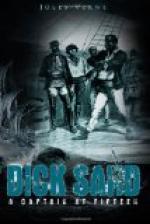This confidence, shown by the young novice, was shared by all those who heard him speak. Mrs. Weldon, herself, gave way to it. It seemed, indeed, that these poor people were at the end of their troubles, and that the “Pilgrim,” being to the windward of her port, had only to wait for the open sea to enter it! The Isle of Paques—by its true name Vai-Hon—discovered by David in 1686, visited by Cook and Laperouse, is situated 27 deg. south latitude and 112 deg. east longitude. If the schooner had been thus led more than fifteen degrees to the north, that was evidently due to that tempest from the southwest, before which it had been obliged to scud.
Then the “Pilgrim” was still two thousand miles from the coast. However, under the impetus of that wind which blew like thunder, it must, in less than ten days, reach some point of the coast of South America.
But could they not hope, as the novice had said, that the weather would become more manageable, and that it would be possible to set some sail, when they should make the land?
It was still Dick Sand’s hope. He said to himself that this hurricane, which had lasted so many days, would end perhaps by “killing itself.” And now that, thanks to the appearance of the Isle of Paques, he knew exactly his position, he had reason to believe that, once master of his vessel again, he would know how to lead her to a safe place.
Yes! to have had knowledge of that isolated point in the middle of the sea, as by a providential favor, that had restored confidence to Dick Sand; if he was going all the time at the caprice of a hurricane, which he could not subdue, at least, he was no longer going quite blindfold.
Besides, the “Pilgrim,” well-built and rigged, had suffered little during those rude attacks of the tempest. Her damages reduced themselves to the loss of the top-sail and the foretop-mast stay-sail—a loss which it would be easy to repair. Not a drop of water had penetrated through the well-stanched seams of the hull and the deck. The pumps were perfectly free. In this respect there was nothing to fear.
There was, then, this interminable hurricane, whose fury nothing seemed able to moderate. If, in a certain measure, Dick Sand could put his ship in a condition to struggle against the violent storm, he could not order that wind to moderate, those waves to be still, that sky to become serene again. On board, if he was “master after God,” outside the ship, God alone commanded the winds and the waves.
* * * * *
CHAPTER XIII.
LAND! LAND!
Meanwhile, that confidence with which Dick Sand’s heart filled instinctively, was going to be partly justified.
The next day, March 27th, the column of mercury rose in the barometrical tube. The oscillation was neither sudden nor considerable—a few lines only—but the progression seemed likely to continue. The tempest was evidently going to enter its decreasing period, and, if the sea did remain excessively rough, they could tell that the wind was going down, veering slightly to the west.




